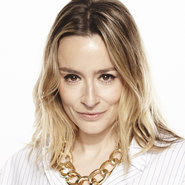By Ana Andjelic
The Balenciaga AW15 show was running late. Everyone was waiting for the girl of the moment to show up. She finally appeared, and settled herself in the front row next to Anna Wintour.
This It Girl was not Beyonce. It was not Kate Moss. It was North West, age two.
Go West, young man
Miss West is the daughter of Kim Kardashian, a reality television star, and Kanye West, rapper. She is also a Vogue cover star, CR Fashion Book subject and the frequent recipient of custom-made clothes by Balmain, Givenchy, Margiela, Alexander Wang and Lanvin.
While this is the less than one percent scenario, it points to a powerful luxury kidswear market reality. This market is growing faster than the rest of kidswear apparel market, according to research firm NPD Group Inc.
In 2017, the global market for luxury children swear is expected to reach $29.6 billion.
Pitti Bimbo, Petite Parade and KID are just some of the fashion shows created to celebrate this growing market.
Burberry, an early adopter, sold $91 million in children clothing in 2014.
Net-a-Porter, always a trail-blazer, registered the Petite-a-Porter domain name.
Gucci opened its standalone children’s store on Fifth Avenue in New York.
Bulgari, Burberry and Dolce & Gabbana launched children’s perfume.
Vanity Fair’s top ten best-dressed list includes Suri Cruise, Harper and Romeo Beckham, and Apple and Moses Martin.
No kidding
Luxury childrenswear is not a new trend.
Back in the late ‘60s, Dior launched the kids’ line.
After a four-decade lull, interrupted only by Ralph Lauren in the late ‘70s, Burberry, Chloe and Little Marc Jacobs lines emerged.
Stella McCartney followed, succeeded by Lanvin, Marni, Gucci, Versace Young, Oscar de la Renta, Fendi Kids and Dolce & Gabbana.
Now, every self-respecting designer brand seems to have a kidswear line.
The forces behind this recent explosive growth can be pinned down to the business savvy of designer brands aiming to easily expand their reach, deepen relationship with their customers, remain relevant and start building their brand loyalty early.
But that is not what makes luxury childrenswear flourish. There are five factors that contribute to the luxury kids’ apparel market expansion. They are:
Cult of celebrity. Forget Tavi, Bryan Boy and Alexa Chung. New front-row regulars are the Beckham kids.
In her fashion influence, the rumor is, Harper Beckham (4) has already dethroned North West.
Described as “the ultimate style chameleon,” Harper is said to have “style which many adults would aspire to.”
While this may be rich when referring to a four-year-old, there is an undeniable dynamic of brands wanting celebrities to wear their clothes and us wanting to know which brands celebrities are wearing. Their kids are just extension of this insatiable interest.
Older parents. There are a lot more parents having children later in life.
There are also a lot more well-off baby-boomers willing to spoil their grandkids.
Both demographics have high disposable income and willingness to spend it. They are looking for “unique, special” fashion items and steer away from “basics,” according to Colleen Sherin, fashion director at Saks Fifth Avenue.
Children-as-adults. With their busy social lives, kids demand outfits to match.
Summer in the Hamptons, brunch at Bubby’s, gallery hopping, business-class travel.
Media exposure, international travel and cultural savvy makes kids as fashion-forward as adults.
The idea of the kids’ table – both literally and figuratively – does not happen anymore. Kids are at the adults’ table, and they are there to stay.
#kidswear. Blame the Internet.
Before Twitter, Instagram and Google, there was not a constant celebrity-gazing.
Forbes’ named Prince George the “world’s most influential toddler,” based on his coveted ability to sell out any item of his wardrobe in a matter of hours.
Forget about his royal lineage. Fashion-forward parents are religiously following celebrity Instagrams in hope to be first to discover the next best garb for their offspring.
My child, extension of myself. There is a strong belief that our kids are a reflection of our successes, beliefs and style.
I personally know at least a few parents who created Instagram accounts for their toddlers to showcase their life and whereabouts, wardrobe included.
“I dress my daughter exactly the way I dress myself,” said a Manhattan mother with deep pockets and a mini-me syndrome. She added, “I really believe when she dresses like this, she feels better about herself.”
Ana Andjelic is senior vice president and global strategy director at Havas LuxHub, New York. Reach her at [email protected].
{"ct":"K34Ej1uK7JSUYcFEwy5AS46ddXe0+Z6XDZnnVC7Tm1cBZ9ETzUKWFhwcEfdGk5XS6ZyIKd0FR+6yCtmsL\/mDEo+eCp37M0xEBK6aOfe7SBx9uGY\/4Vh5sX4EsldtG2DUFqfwqOw8pQEnVN7TP+2NyJFFS1S5eBnylxIcReau8g2vxmeO04t32VZ9ZaIiS31uPuTxxR\/7gYo9Sbr4pTL5PPDCKuCN0rbo7Iv3CGwMRAJm6UPbsoEpm7nvsDkcxLLSWt5Pwc7+TPLJEX83BL1EzeBvp3aG75X8S6yTu\/kaXHEYE\/NYcrOuwbl27TnB+p3zJGz7xD6FqL4yNyiI3ElnZm0HVd7Na\/HnNX99d1qj+GcC4HQHFooFpveaWI9oAq0oyP8ORxeMPJrXBktiWDcunVz54kRitmjkdlZ9zvugiFl666moWPq+n+g8O98f\/VJpZMUmYSx1a3\/p+iD9\/SvhbvulULbnESz1uT32fWSJGRPvPrCWFOf1cvDwxH7Q38SKJE5QH312ePjx43Bn7\/tZyfpla4iPSZlRx9gvdk4BRdeSTQ2Pd7HUTFCEu7KMNvmCUljex6QEHhVMJIIlTPSgi4XPh1+y+ik8ZRzhcB97c4ozaOJCKki5sjISI2velMDUU9N8j8U9\/jga6zbn7\/VR4+2h9063AZUlp2oPZ3j\/KtiWmLXTWLnSuIJqzh17P9bq164RnHVFRzBuYYQsO4LHW7ELOglQXl+\/KiVMIQxlwBscgMdTJhWJAub6ZujVWN8r8JDrCBgbqm\/TRlkTORrhhGg7OuFaNNrg+QKIojQt+++N1n8jkfBp1SQtEo\/WXhepEC2vKloqfIvE+zUCM1JC+aVMcYV00KIrCKh1DzgZcnQ\/i5Sww0TQbTpwmCICt037trSgrdoHDvDtGYd54eYyDpB2X8UurfUgt6+VrJh2E7\/fbHCWL6s\/iHHNnl4fgonbiHZAE3wLOAfgy+27UazY1GKLn\/0EnMVrQgQv0wRaxDJt8s183CDD8E75ABtHuFCpSyN4K4ZSs61mg3z2\/uPV6xSQMgBtmO03lijJL+eDhtuuNuSXHFyKlE1hKl\/Iy96zRo7MK5xpNQ4FsXO+ufG7UW37vwSqsDwSE6sRXxpM8TsCTCM2k+mTItreRtDtxIEhGRKvsjSQxaAuANiDTPEu9RDTwCMrtml6h1cOmVyGlQpIz4820rtDII7eQ0kySzgwnLpNr9N\/oSLG7CMny6AWZvFzPdZBvldjM7\/nRqVp7CFi1MLXIchkZAhdRugyy46ykQh3Efe5fkjYO1EwxeAnJeAn+dO0jD41kBseV4tXGB76mWLUb9\/oqNHV7QU69EiRVhv+Fi90EZ3wFFnqXKZEMA5fssBF7oBsr7fuLecaMZ8estjPjoqAnmGOGhBqZCMwG9MLyAJjYQYFfIjutyjGQKLwsJzA3D68IT3eFBQspOoYPoWx0bPAgp7UvrktUEn5Rrd7MTSlo9Ozv+1txc8BGj3wLf8HpZDrfwj6+KW7iFdzog4PVHpTwkWIrqi\/K3eR3dvE\/bwB8cM4i8PvIpEB62cmug612HlMbHqnzEZo\/U\/3jlFK8oO8v447Ly\/RCiYTTvZxuCnpXW8cM3rg638LcT+h7mrYTryWmn+C8kr3Ch6v1zoGqGpRkRAcTZzCi\/V0+MT4L5AvsxCTkjlrn2ibouABdHR61ivwsuqp7Fud6TymIF+VTedzLPK2Fbz0rNnFbYzGz7hW9stcVqmYSNigiIGv7kdaHVfm2oKJv+h+L5HzvD\/55ayN9y9OAIS2T0FKFWGn37185F1C4Vbuas8R1IvZvtAyiFgfjbMVTnfYybNjn1oPZ0qeJ7QD\/PLCS7QagWd6Ncn3My8BGiGz8zDhcocs7DvTqSl4DmNwuTrgWOYMhJgtSb3KsgNS+itnzPMYor9qpXk\/\/lLcskdWTP+T7IsE2SafxureYwfW2WXP9x6Hm2xwzDycpNGnhHeMM\/Xih9IN9N0FR0iId8uDSz1MlU0iwnYdAvsLONaXs\/vd+0lMpYpvOSv2oSeiQC5uPSasKOHv0p2oFwJnysdxrhAfMRsy+VJ+o6SwVCdDq6Bz0fqAuKL0kOIoXYN4iyUXFItO6Z5xc6et5hc+g6hlnfo8hl6FJ03EIOJlaPtLsoay6qBxedL+NyhapFSYgKNEN7+8OHLQfCQeWEubja58iJQvGDY6MMIGNi12Pjsutkau0dBKw9BmtmA+0RS5g+rsZ3NpBsW2Jh1eJYyWwzZc9JWYVvPodgRRJyDxwy1ZNhDDuwJfIe\/SOOZumqaOAk1VSa8o0GyGEyN126N5BBc0uNWBqAmQrv4Dc6Ayv6RdfJGQp\/lm1W3zu+00fxQbwnmobMFfk2ZC2bWBOMHO19tMVPi1KiTNDI84QTCfAoD5GWKd9GwnCFUHh0x1\/HtPSZznEZMaxaUuK4\/KnEoWsqyubzCfkohiKWejWIwkQerK9ML\/\/lQGMv\/6XP0yj16qG0tgkPHP5VgtJN1jc9Y0YIZcj4K9kt9mztWeTBViYRfk9+wTonKsw6\/aXptGap93YM22KeJyNRHAYHgPIFTvzfxRaADImHLqwjkKWAgmkBQhitqZNvW\/yMMDtQ33JIZLaP9nC6Sb8+4DgrO55TIcrte22MSy8V3vKjYLFcwkCvq4616agPN4Vs9M8SLo2k6rbRSA\/\/4n0K5uKghhh\/ubcRmwjvGE+zFj488gCgA5GrCMRIwDyLMP34jCRccJuGCNK5l\/yX3MMRwpseEmEUIJLzDn5bAn9QfkXbJvxUpnxzAoiv+KSxkexuN6L9joZaBpLP2Uey6f5kuIMvcRyXaeIAnRZyFKhUHynYHcA1onNMH5Rv3tYAoj7nR2HD+Xg5Jjo2o0AvDm8ZcFSjo\/1vsA5K\/vwGxU50clIwMzBictfXRPX148Vd1dLcsK7ku1aX4rVIgDZwD3TEmRPZRIC\/Asv+yZxDWlwLjYDrBrp7bOgZQscp07kVZvzzRUeaX9FWAw4CA7\/3kdracjO9gf5\/gKygZ58u1EwsvrWIByseThXEnHBTn045f6wR5dEGGUQ3QEgCNeSOtThCdoHApBYvetESpIuwa1IwDhnPtIe6FdLUG+ChBuKYhwLFsUrIhjo9B9cgNECrKhXcc+xKckPAn2xintsrjCmFb18sTQeViqDHSUDzwzgTn8LSEcLwpXJYTeod0UEdr123kuFYigxEEWfZXcgh891dFAU7Qj+9GlUmcLZFnZa8fuLWc02r3JFseTyRRJmVeIYo8mWfQiFKWcKpZZQlBTtDiYA83Vj4JuzN\/erdEwYzKVBlnQIjc0OjWgWSXpSoMoWz5J+hdDJPIiL3I2C3OmRi0wuPSAyYk6JYsofqbYv6gsSSLGXZ8E6n+VhVicC2RT6fexF2nD76Hy0MZQfjbVXVWEXPKfAUhS89\/1gbBaF5dvCvFro2ntAfCgZnrh\/W8+MEW0mJEckROC\/wpVA7miQJrpDAf\/\/66Cmi3VXQSJkLso7N0E8tW5pVQMZ5YjHukBcNHss7\/KoHa0pgAdufqSVD2MISE9BJx3ccVgpLAUDFRt\/VGOt+rdla5qS9tKsINJsawMff4vwZZ0911RhvKqzW2050Vqg97USmc7eFTXQESl0MybN2W6KWDNUusLhOqS01cygYdQIUUdn8Wi44SZJGIYTEEelS\/md9h8oTztf7vhVp2bZQpIj77EyhRwaWdK4lt57NMEQluLoYPZDCQ0luBk2eM+6dr5QMOKox1pi4zva\/aNk7tbmDgCGN+GdFaNkk9G+PAFnQad4\/jag2fsaIvy0G6pTxA88FcHQ5XzHdMAwlyAu1JxB7eTmUJoEasN2IZdf5UVhlRcICw4vMD4WTLaxKboDroOQvrubi\/GoRPY4FsEfN39VOSnenLl09zxDrhqpKTUFCsc1Sp4SM7c\/iVcHJBz+jq7pG1R5AlBnyuavOe7vRA7mWOix0LkRYRiDRpAdypLDJG3uiidn6MSqpoVyfsQR48hgNqE4CLz\/Z7xFCI4Tm8j\/OlFL\/Pn\/tzc2HcZlsfrqLqj0L9UlQRTz9jf9Fd+UaGAONX9awi\/VHGNsEY\/jd4y0fDuy9Q1zBzRlRy1NaCXtAE6JDmcLF\/r39t1Hs3T9xWAdtJGFOTCQ\/YiuS1ZoTk5k\/kg7ZAJXSAgyX0bDOm1BALTrFp6+mLG8A+l7qlKkSOBIUzXaMvK8C3BNl0GF6j6r\/WWMCnIV5wqPFh3Hxlxx1+nhVKjRMD+eL38D5L7UKXBWvFL3uUFG4MT51xoetcR\/sCZAOvMTXBPfJis7ZyKTQ2zpHKDCEyNf5Xg+W4MTz5KEkDlXOegc74oLxrF1p0cKMz8uJwYCS6PCl6jCnkh5a7Pj5Ou8X6Em7+st2HWyaW7Z\/Zo\/ox5caVLhWV\/VZ7GCnp+T23TZj0An9butkVRWb88ucEhemaN9E3+UsW37zIPDv6y4TAFxkvHPRtkrf07inTOSkTNE6rmbnWQSTLU0aWb6UG\/5gJya+op7jw2blB0038\/2jJrbnSwW7PV7YkRdK\/+8789z56jvXIZv3uf9B\/PoiQSVwExbz9Wmw4efpUKCOKUhZPf53Hx+4dO2DTbOI7KE5cFghNEt87ETZtZg5Mby273i4gfSf6FEBW4phx9zFVjsgZUSGF88Ycp2NDacyOURtV6ocjVwUS\/u9oE0SJHViP5C0nfcniqFpZtqoXm\/cpTw6KY9cndaZIgHtjg\/Zu0AtOvzY4PffZd9ahnkim4Ly4S1XlBqqtxZYocZyW06bqe\/Ti6KUTn3F2SHE4Pz8mwyJJMkSXOQmMDlSK4+mAit1YHfJS+gDvWv70\/8I1s54or1sBSZs\/o4uW8X\/63XcozYe+8JGJ+dqckOnwEHegBlX0ppMuDK8YfgTXk7My\/Ppu4H8hnaqs7T1k5asHFzsbFE0hhGfl0Rk0lQpOkAit+a7qXTnwzNm4jrLXfcRjV2pKdo4TrRdQfHO1xdnE0uSjYIJqLGHxU5qZSUi3eivfzpzo8teCwQ47CHXr+vzetsC2zGTVj5YRbfQKcZSunuDT3yao2kHvWmhgYshBtmA8FTo3bd8Q+E4pmElnf8nXh6ghX\/JAOTV78uY416xCrn6QQKb29NqmJxnWqIc\/k7dYEq52t+ttF0neqSJyDnG3LhADuBhZ0fcPtsNO4GPzvKId8MYFbHop67ABA\/AtCyP+bmaoKTAfJVfiRPYGA7t1cLcGwmdr\/H\/nbJP3OTekrYsPbl8VAS3YKbuvTZQcknD0R1KS3zasyabIxSDuBKS8OXuKsRxwHtIolVzx0Va4acO6wYE991j14uwUummklOei4Z9Rm+2qp7QuEzPagCUZpYrrzyg9aIZq59ZPDJ3+6HEdxOHWIyoX4Nxc5fOJajBbDt5zBE6autoOZEYGATK1nYrzlhfmYJ9gTZTzlTzrwvp0rDu\/QQ0vzRu5aylg3OA+hVl\/j2Av1fzr8Yjoj38BZ67fsmoa7wLCIXEfKTiJvypVkHTJpB84Lx91zwLdSNWcKvKdRRdA63S23ozFpj5c5j3HPPNUxJ9Lgfgd7TCYD0WRBqfaKh6JgIDRl\/VcsF4R42yMyI5581wPnw+yEPeIKC1U3B02ZmovpjDBFmK1YbjPKyk71QTrYX4ujzSvVSw56MePwIu2YFTMNdvDK3dvzF\/5Z4CdSLANJgzQhoTuNaUXaO+loaldkz+R1U8lrGfoHZKIJciZJISDcCgZobkfP9+9VgTpt2u6NgX0qO6MtIQMkkHeWQWOIgh0OelRvU\/Rlzu3Q3Ut\/NXrp5TcX37FgEm7vf5x2MgUusaAUlTgUtLhoxZg1uQJ6TIB3j+5DmoPhZ6tIgMGNQUCKVymvV7JBkh9GIaX5uZAk0wC3PbZxM1gdeubJbFjfY3sF+or2umTjpx7q7Rp1CTjv69Qc+MMrDDzqemBK1u6bCq3k\/pO5Qw03FNXPauRVhKlyM8TmRAAlpyAKPMpwJ+5eOw7b17PULEiUP+dyXbuaE9LOZ5EXEfZOkENoiGSM+b4QLKA9HlCjTFDe2y\/VjImQXK0X5m1c+iRjLN4dSiY4U7orB\/yFWqHvwhePncxIK7LG5P9outINz6VLBY+b8CP3nwHX+fR6Hj5GGWZCEdMur6A8irAoatskWUsSKIlzIJNyvPjzPCenaqk8NbadaXl7j\/xwUSv77XFp9\/GSFhSvsVSrasvaPt8aDPr3RJCRY\/UWa2s6Zx+rV50VawDTqVlS37SDYt4Tnm4H8gpPUhfSSeCpSM0uAiU0hYShZjMssZnjJPxaFJsqg+CQdRYJa35crZRkyWpPpkxdOINuASDxP781GCZ8GAp26GLwTRHDXScgNpk\/alkWLmcZcD9wSSodS68ErRb\/pJavjGp5eZ+XGcjpaKJdwuKqEoeqtg\/7aX+ooqZKgt2uiKDcjCBHu6oUzCr4gggkoc2g+mUSqw1KDxNvks6ikxUcPSHaFqcDZUijyPH9RXRDQmrh72FpkS4EXZOtwA1tkrbe65hJ4AbIAZTxHFodFvAazfUx2at8XwHC0RDMKwZCmL5T7NFyMO6781jKS4zUD0ciTUH+Q7DV9tH8sTIE1hjnCr4RtLVTsKoEOQD7r2\/q0smDIEMMKW1\/RoSJ8hgLsZ0mHwDB1SuOl9BKg6GhdWchMZ+CrlED2sQpOZ2wQmqDvfQYjSY42trC8NJNGgPWiIu\/qSDZgM37oMQYceXqG1+5clKE9KODr8MtH1jVjlxWLQYqf\/UFshGpjrQYSPYGSlZ2RpxtT3EImM3JdicOX1PHxPp8m1BcMu2GhaYQICKCan55BTkD07JkyDKeD35yeB2MGaqa2G+mxb4hEO88LKwIeqSPik9RM1CCo60ly95GE2oWH+nCYpZ5pbrQEHeDxynXKrmZPuFolENdA6Eg0XSNH2JZ7I17pIHf1nvzqk2TGtkv+S9h4SHxiivN\/mseKo5LcG6pc5rCbA408OCApHl9krNFaMC9Peky53XccDlB16WKlWb6CQrqkL5hA4PoUSQUICYws8Kyzzu3Eqvhf0Aqz42NmKAaG9AgRh0znAmOiE7do1jXupIRStNWzSREha7fL1wTM4y2rhQcAVk9qxgVtEf2JEGGYwe9PufFuaiDZ6fJjRvYRsfceSJlPbXLK9HfU3K3Q7XTWDVmrnuDZyV66BA2I55vRjNrOkX\/mTafHpf4wUQAW6rUaXcD97RQH+i3Rmlh3zv001pDsMFVV5SFfcBiM51HoLYRKQ+vysnVcJCg1qMtqKPlVOYqIw47hk884iVLokOh88d3awqDpKAZ7EA3sJQGBNwNKIFnoBQnnO02QaDqexyObi0q3bXso1KIptfnL5NqzyHnLPvmNWWDdj9MVCPf1OvEuxEAVIapbxq31INGMj5ydBw9yw39AyXT1RzClc1qagbrC3mRegvSn6n1QMLA8YefAwsThciqwplG0AzGtt2hlNsGgozbZGm2RC3WFf8Wlz2\/D8y51c9RfxZjhK90QTR8UtxVSjuiwxWE\/QVTaO+Uh+IqNr4YFQ\/jtb02vmsif\/S6TBmlQIL5OerncInX","iv":"bfdf6a0290e9ffcbbc7959e0906d288a","s":"406c1899dfe3fcba"}
